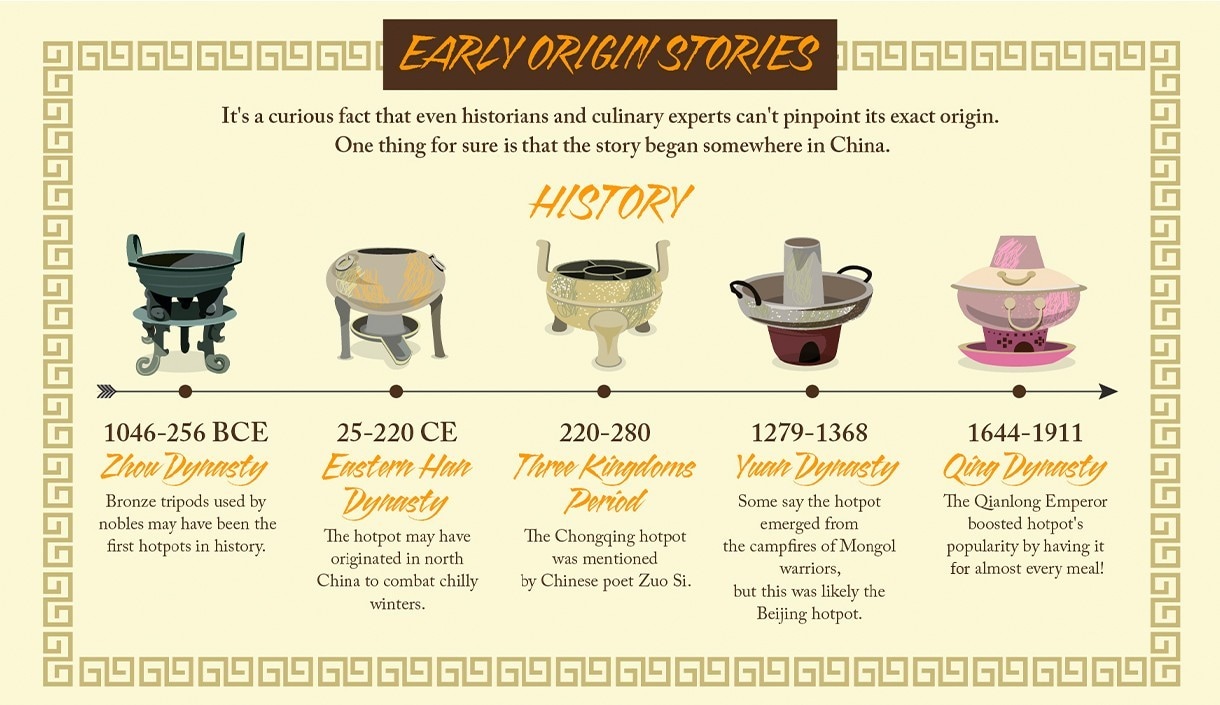As a chef, we’re confident that you can cook a tasty hotpot. But how familiar are you with the history of the hotpot? This Chinese favourite has a much more interesting past than most people know about! Learn all about hotpot – the origin story, various hotpot styles and types of ingredients to help you incorporate it into your menu.

A Brief History of The Chinese Hot Pot
Hotpot has a variety of styles, and each has its beginnings. It dates back hundreds of years, and some believe that it first originated during the Zhou Dynasty. Fast forward to the 19th century, the hotpot had become the common communal dish we know today, with a multitude of flavours and ingredients representing regional cultures, from flowery and fragrant to numbingly spicy soup broth.
Here are six popular Chinese hotpot styles that every chef should know.
Types of Hotpot Style
1. The Beijing or Northern-style hotpot
Cooked in copper Mongolian pots, the traditional Beijing hotpot focuses on the quality of the ingredients rather than on the soup broth. The most important ingredient for northern-style hotpot is thinly sliced mutton.
Character: Simple, fresh and lightly flavoured
Broth: Boiled from bones with scallions, goji berries, and ginger
Popular ingredients: Lamb, leafy vegetables, tofu, mushrooms, glass noodles
Dipping sauce: Sesame or peanut-based
2. Chongqing-style or “mala” hotpot
The Chongqing-style hotpot is known for its rich and thick broth boiled from beef tallow, and butter and achieves its numbing hot spiciness from Sichuan peppercorns.
Character: Mouth-numbingly spicy
Broth: Sichuan peppercorns, fresh chilli, meat stock, premium butter
Popular ingredients: Beef, lamb, cow stomach, tofu, green vegetables, sprouts, noodles
Dipping sauce: Sesame oil with mashed garlic and chopped scallion
3. Jiangsu-Zhejiang style flower hotpot
Well-known in Hangzhou and Suzhou, the Jiangsu-Zhejiang style flower hotpot broth is usually made with chicken stock and cooked together with chrysanthemum petals, giving a light and sweet flavour.
Character: Uniquely sweet and fragrant
Broth: Chicken stock and chrysanthemums
Popular ingredients: Vegetables, sliced meat or fish
Dipping sauce: Various
4. Yunnan-style hotpot
For the Yunnan-style hotpot, mushrooms take the center stage. It is famous for its spicy broth flavour and mushrooms, which focuses more on fresh vegetables, mint leaves, flowers, and different types of mushrooms.
Character: Fragrant, spicy and eaten with fresh vegetables
Broth: Vegetable stock and mushrooms
Popular ingredients: Fresh vegetables, mushrooms, fungus, chrysanthemum, sliced ham, pork, chicken, fish
Dipping sauce: Chilli powder and sesame oil
5. Guangdong-style hotpot
Home to Cantonese cuisine, Guangdong-style hotpot is known for its fragrant soup base and focuses on fresh seafood. Seasonings like spring onions, ginger, peanut oil, and soy sauce are added to the broth for a light and fresh taste.
Character: Creative and varied
Broth: Various—including Chaoshan beef-style, seafood, chicken and congee
Popular ingredients: Various—seafood, meat, vegetables, tofu and even fried dough sticks
Dipping sauce: Various
6. Taiwanese hotpot
Influenced by the Japanese and Western flavours, the Taiwanese hotpot is made with clear chicken stock and served with fresh vegetables and thinly sliced meats. It is best enjoyed with shacha sauce that gives a savoury and slightly spicy taste.
Character: Fusion of Chinese, Western and Japanese flavours
Broth: Chicken stock or bone broth
Popular ingredients: Vegetables, fish and beef balls, thinly-sliced meat in shabu shabu style, noodles
Dipping sauce: Peanut, sesame and shacha
The foundation of the Chinese hot pot is a good soup broth. If you’re looking to introduce a hot pot experience with a modern twist, try introducing a cheese soup base like Ginseng cheese soup using Knorr Instant Cheese Powder Mix! A novel and unique combination that gives a fragrant and light flavour, your diners will be in for a treat.
If you are looking for inspired ways to innovate the hotpot from its traditional roots, check out these recipes for local, fusion and Japanese hotpot inspirations, as well as ideas for dipping sauces.



